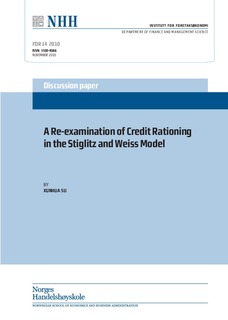A re-examination of credit rationing in the Stiglitz and Weiss model
Working paper
Permanent lenke
http://hdl.handle.net/11250/163995Utgivelsesdato
2010-11Metadata
Vis full innførselSamlinger
- Discussion papers (FOR) [566]
Sammendrag
To explain the widely observed phenomenon of credit rationing, Stiglitz and Weiss
(1981) propose a theory of random rationing under imperfect information. With a
simple model plausibly expanding the Stiglitz and Weiss setting, we argue that, random
rationing occurs only in some extreme cases and hence is not likely to be a prevalent
phenomenon. We start by illustrating that the Stiglitz and Weiss (1981) model and
hence random rationing are quite sensitive to the assumption of the ranking of projects.
Given that the ranking is according to the Mean-preserving Spread, there is adverse
selection but no moral hazard. In the absence of moral hazard, random rationing is
almost impossible to occur. Then by presuming the coexistence of adverse selection
and moral hazard, we derive two required conditions for the occurrence of random
rationing. First, random rationing occurs only if collateral has an overall deadweight
cost other than the negative adverse selection effect. As collateral is a widely observed
debt feature in practice, such an overall deadweight cost should not be the case for
the majority of borrowers. Second, the occurrence of random rationing entails that
the potential negative effects of the loan rate, collateral, loan size and any restrictive debt covenant simultaneously overweigh their positive effects exactly at the current
contracting level. In this case, the zero-profit curve of the lender degenerates to a
single point and borrowers face a take-it-or-leave-it offer. We conjecture that such a
required condition leaves little space for the significance of random rationing.
Utgiver
Norwegian School of Economics and Business Administration. Department of Finance and Management ScienceSerie
Discussion paper2010:14
